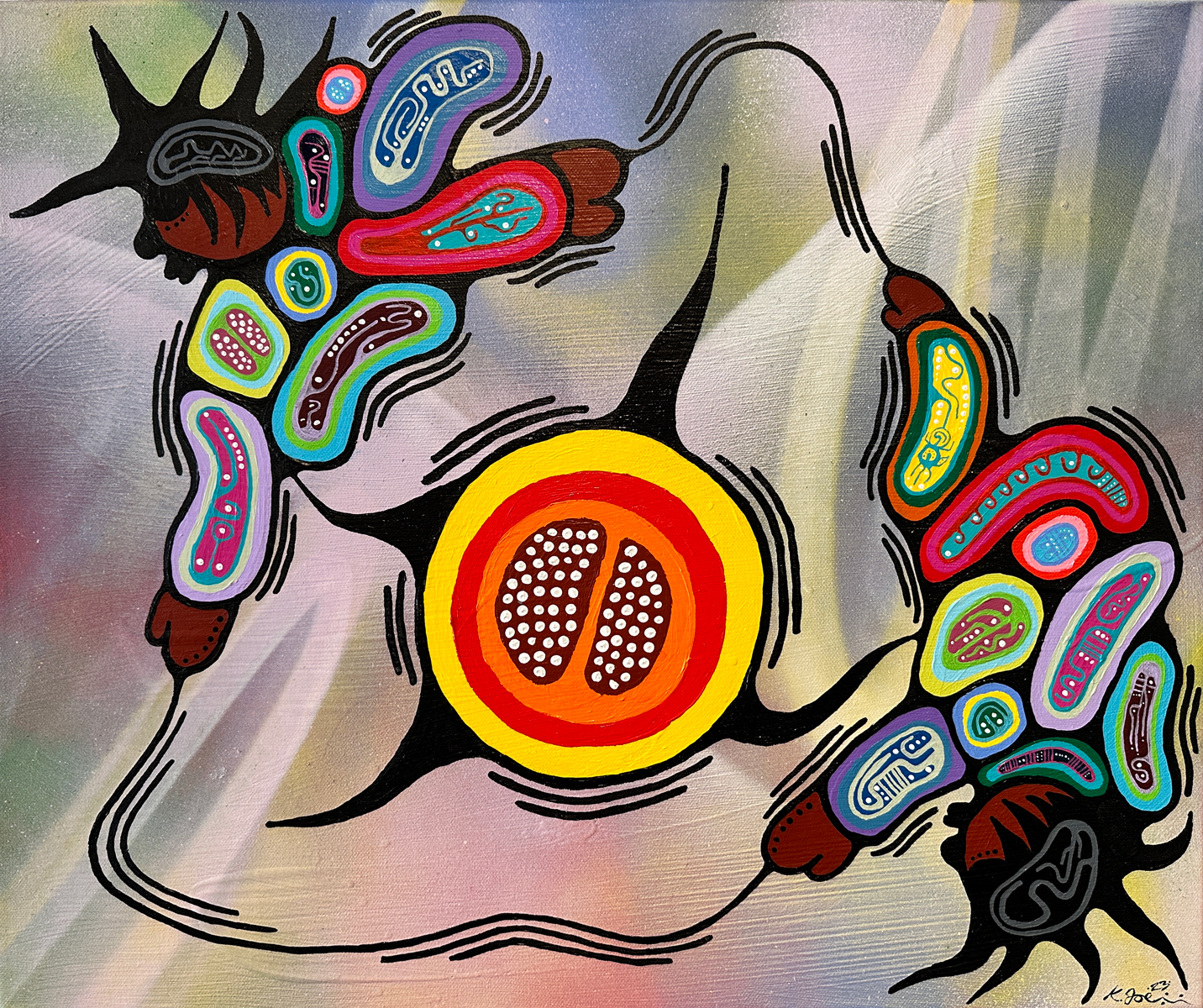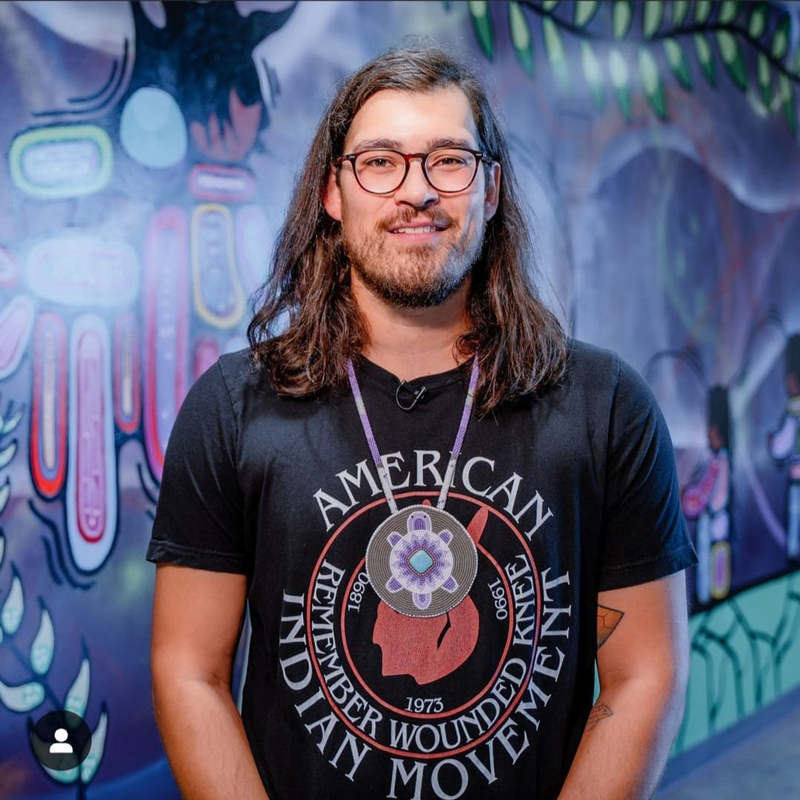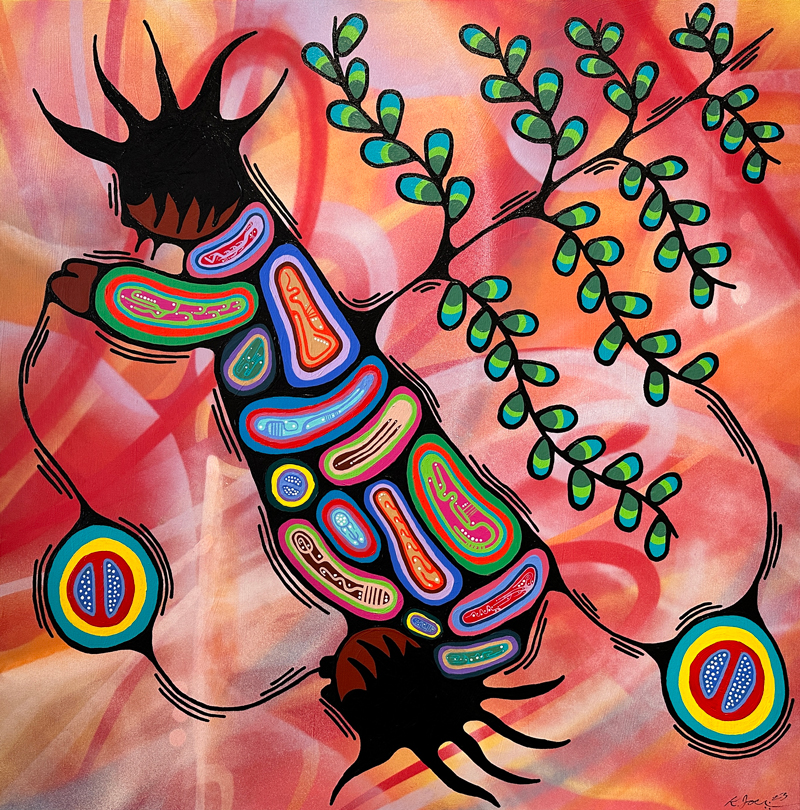
6 minute read
Indigenous Artist Kyle Joedicke
Indigenous Artist soars to new heights exploring culture and tradition
By Nelia Raposo
It’s been a big year for local visual artist Kyle Joedicke, whose work will reach new heights as part of a 3D inflatable installation by Plasticiens Volants, this June during the Strawberry Moon Festival in Lewiston, New York. “It’s a large outdoor music venue slash festival space. The event will have traditional dancing competitions, drummers and singers. They are turning the creation story of Sky Woman and Turtle Island into large balloons,” he explains.

But no need to fly to New York to see his work. He thinks it will eventually turn into a world tour.
Closer to home, his art is on display at a few Steeltown galleries, including Beckett Fine Art and the Art Gallery of Hamilton. He’s also snagged commissions from several corporate and non-profit organizations.
Anyone travelling through Hamilton may have already seen his street art. The 31-year-old Indigenous artist’s colourful creations are hard to miss. “I want to create more inclusive spaces – places where the urban Indigenous community can see their heritage reflected at them as opposed to living in an environment that is very stifling to traditional Indigenous ways,” he says.
Joedicke describes his work as Woodland, in the style of Norval Morrisseau. Woodland Art, also known as Legend Painting or Medicine Painting, is a distinct style of Native art that blends traditional legends and myths with contemporary mediums. It explores the relationships between people, animals, and plants and is rich with spiritual imagery and symbolism. One of his murals on Concession Street in Hamilton depicts the teachings of the seven grandfathers (buffalo = respect, bald eagle = love, bear = courage, Sasquatch = honesty, wolf = humility, beaver = wisdom and turtle = truth).

The Halton Catholic District School Board hired Joedicke to create seven original paintings of these Seven Sacred Teachings for one of its schools.
Another mural can be spotted outside St. Matthew’s House on Barton Street, which is a memorial for the unmarked graves of Indigenous children found at former residential school sites. “The biggest takeaway that I’d like a new viewer of my art to have is that I’m trying to bring a much better sense of representation to Hamilton and Ontario in general, for the Indigenous community,” he says. “For a long time, in terms of the history of Indigenous art, it’s kind of been seen as not necessarily fine art to be put in galleries, but almost more of a touristy kind of knick-knack. Like there’s been no real level of professionalism attached to it.”
His dad is from Six Nations outside of Hamilton, and his mom is a Scottish descendant from Caledonia. Despite his mixed heritage, Joedicke identifies himself as Cayuga Turtle Clan from Six Nations of The Grand River reserve.

As a young teenager, he didn’t always declare his Indigenous roots. Often, he would pass for white. It was safer that way at school, especially during tensions between Six Nations people occupying the Douglas Creek Estates (DCE) subdivision. This was a time in Canadian history marked by police raids and clashes between Six Nations people and Caledonians.
When presenting art workshops to students, Joedicke doesn’t shy away from his personal story. “A lot of the time growing up in Caledonia, I felt too native for the white community and too white for the native community. “I know a lot of people growing up and going to school in Caledonia that had to deal with blatant racism, especially at the time when the Douglas Creek Estates land complications were at a peak. There was a lot of tension in the city, and it was at that time, easier for me to not necessarily hide but not put a spotlight on the fact that I had an Indigenous background. I was in my late twenties before I started to realize that it was okay to express my identity,” Joedicke says.

When visiting with grade 7 to university-age students, Joedicke says, he enjoys “creating real connections with people who truly may have never met an actual Indigenous person in their life. At the end of an hour-long discussion to have a student come up to you and tell you that you genuinely taught them something about your culture is... that’s a feeling that I don’t think I’ll ever forget.”
Joedicke, who previously worked as a landscaper and general labourer, still can’t believe this is his life.
He began focusing on his artwork about three years ago after he was laid off during pandemic lockdowns. “People see the art world as a very exclusive place where you don’t know how to get into it and for me, I’m a self-taught artist. So, this has all been trial by fire,” he says.
BeckettFineArt.com/Kyle-Joedicke • @KyleJoedickeArt

BECKETT FINE ART
“As a life-long supporter and collector of Indigenous art, I follow the work of many artists. Kyle Joedicke’s extraordinary work intrigued me as I’ve followed him over the past number of years. His technique, consistency, and vibrant imagery ― with a nod to both the traditional and contemporary ― took me back to discovering the stunning work of Arthur Shilling decades ago. As impressive as his work, is Kyle himself. A genuine, kind, and giving man who is dedicated to his craft and positively contributing to society. Please contact me for further information. I am proud to represent this outstanding artist.” - Tom Beckett
Beckett Fine Art, established in 1966 in Hamilton, Ontario, represents a select group of established and emerging artists including painters, sculptors, photographers, printmakers, and other mediums. We also have a long-standing reputation for a stunning collection of Canadian Indigenous art. The artistic styles of our stable of artists varies from contemporary and abstract to traditional and realist.
196 Locke St. South, Hamilton • 416-922-5582 • BeckettFineArt.com










